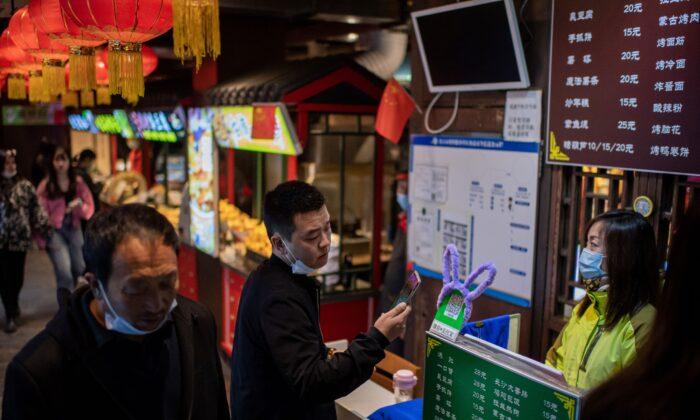Commentary
The regime in Beijing recently completed digital yuan testing in a seemingly innocuous manner. In the southern city of Shenzhen, the Chinese Communist Party (CCP) distributed 10 million digital yuan to 50,000 residents in the form of virtual “red envelopes,” a whimsical reference to gifts of money received on the Lunar New Year.
While the “Digital Currency Electronic Payment,” or DCEP, is China’s version of central bank-issued digital currency, it’s anything but whimsical.
In a traditional electronic payments system, transactions can only occur between two bank accounts, or two accounts on a payment platform that are linked to bank accounts. With DCEP, transactions occur between two DCEP wallets, and neither wallet needs to be linked to a bank or a payments company.
The DCEP appears to serve two main purposes: one is to increase the yuan’s international reach and become a leading global currency, potentially replacing the dollar, while the other is to allow Beijing to mine financial data from people who transact with the currency.
Regarding the first goal, China’s efforts to expand global yuan adoption have been unsuccessful. As of September, the yuan’s share as an international payment currency sits below 2 percent, according to SWIFT (Society for Worldwide Interbank Financial Telecommunication) data. That figure has barely budged from a year earlier, signaling that the yuan’s international “market share” has stalled.
A new-fangled technology underpinning the yuan currency is unlikely to increase its popularity. Countries didn’t use the yuan not because it was technically inferior to any other currency in circulation; they prefer to transact in currencies that are liquid, freely convertible, and backed by a stable economy. Whatever deficiencies yuan had, the DCEP doesn’t change them.
What about digital convenience?
A common misconception is that DCEP is a cryptocurrency, but it’s centralized and doesn’t run on blockchain. It bears little resemblance to popular cryptocurrencies such as Bitcoin. It’s a digital form of payment. But the world already has digital payment platforms such as PayPal and Venmo. There are already highly sophisticated yuan-denominated mobile payment solutions out there, such as Alipay and WeChat.
From the end user’s perspective, there doesn’t seem to be an advantage in using DCEP, which brings to mind a central question—what problem is the DCEP trying to solve?
The DCEP turns out to be an answer to a question that nobody asked, at least nobody outside of Zhongnanhai.
One quickly comes to the conclusion that the problem was a lack of control. Legacy payment solutions—paper or digital—don’t give the CCP the level of control and data it desires. The M0 money supply, which represents the amount of physical cash in circulation, can’t be traced and is the candidate to be replaced by DCEP. Even Alipay and WeChat—which can be traced by Beijing—are first and foremost controlled by business enterprises, not the CCP.
China’s supposed goals of internationalization of the yuan and digital convenience appear to be red herrings. Or at best, they are secondary. Control of data—at first among Chinese consumers, then international consumers—seems to be the primary objective.
The DCEP could “create unprecedented opportunities for surveillance,” according to a recent study published by the Australian Strategic Policy Institute (ASPI)’s International Cyber Policy Center.
The ASPI report acknowledges that China’s DCEP is no lock to become a mainstream global payments platform. But Western governments can’t afford to simply ignore the threat.
“The initial impact of a successful DC/EP project will be primarily domestic, but little thought has been given to the longer term and global implications,” the report states. “DC/EP could be exported overseas via the digital wallets of Chinese tourists, students, and businesspeople. Over time, it is not far-fetched to speculate that the Chinese party-state will incentivize or even mandate that foreigners also use DC/EP for certain categories of cross-border RMB transactions as a condition of accessing the Chinese marketplace.”
This should give Western leaders pause. Think about the current hand-wringing over Chinese telecommunications giant Huawei across the Western Hemisphere. The Huawei debate is largely driven by security risks—that Huawei would grant the CCP troves of foreign data.
In fact, Huawei announced in a recent WeChat post that the new Huawei Mate 40 is the first smartphone that enables a hardware wallet for China’s DCEP.
So China’s DCEP is an audacious form of data harvesting. Each cup of coffee, bank transaction, or peer-to-peer payment is logged without permission and can be leveraged by the CCP. And from China’s perspective, that’s a feature, not a bug.
“A successful DC/EP could greatly expand the party-state’s ability to monitor and shape economic behavior well beyond the borders of the People’s Republic of China,” the ASPI report concludes.
Western central banks must wake up to the security and data risks of China’s new central bank digital currency. A global currency and payments solution, once widely adopted, will be difficult to roll back.
It’s a Pandora’s box that international central banks can’t unwittingly open.
Fan Yu is an expert in finance and economics and has contributed analyses on China’s economy since 2015.Views expressed in this article are opinions of the author and do not necessarily reflect the views of The Epoch Times.






Friends Read Free